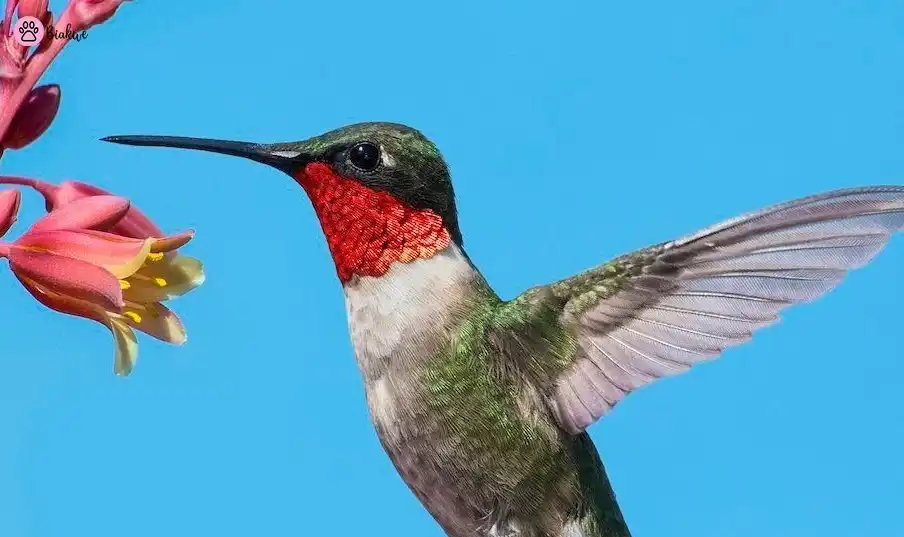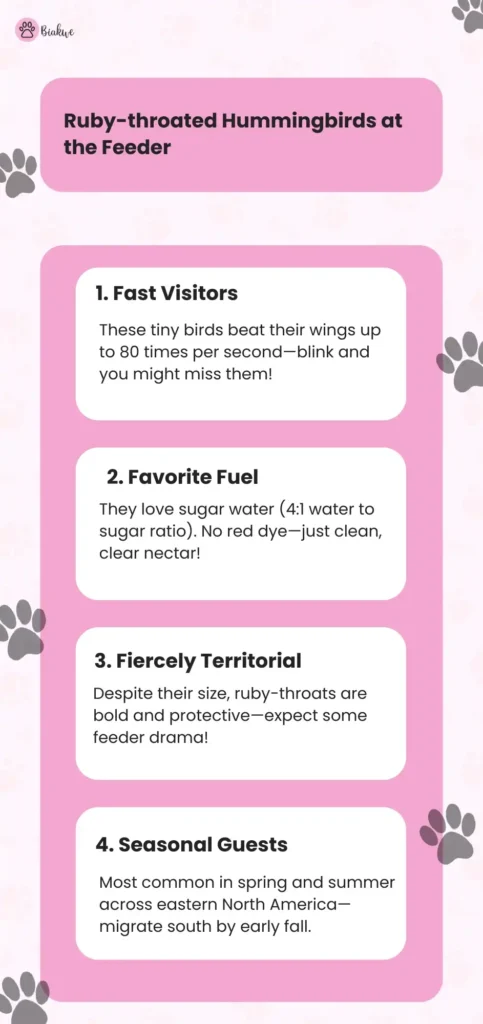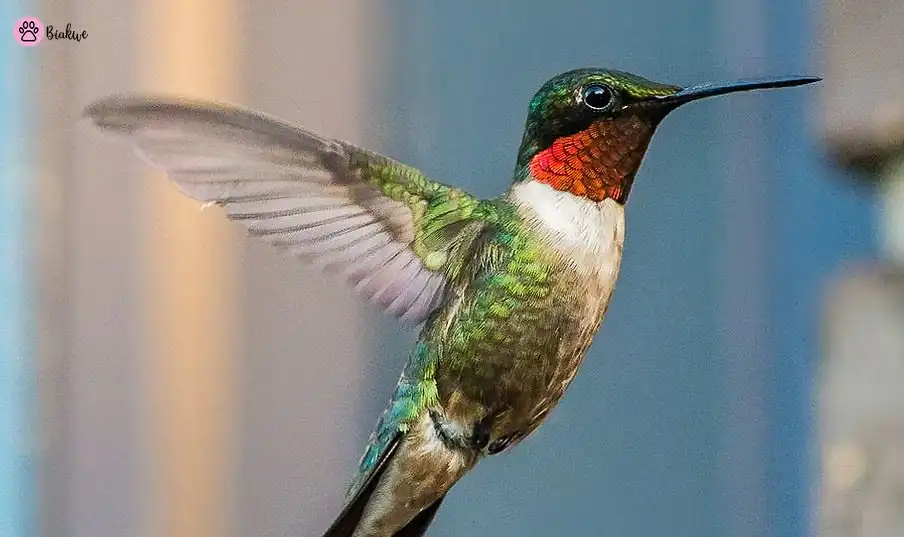The Ruby Throated Hummingbird has always been my favorite backyard visitor, tiny, fiery, and impossible to ignore. The first time I spotted one hovering near my feeder, I was hooked. That shimmering green body and flashing red throat (on the males) looked like nature’s own jewel in motion!

These little acrobats are wowing hearts in North America as more bird lovers set up feeders just to catch a glimpse.
But what is the difference between males and females? At what time do they migrate? What are some ways that you can lure them into your yard?
In this blog, I’ll share everything I’ve learned about these zippy birds, how to spot them, feed them, and turn your yard into a ruby-throated hummingbird hotspot. Let’s get in!
How to Identify Ruby-throated Hummingbirds
- The Ruby throated hummingbird is tiny (bigger than a thumb); they can grow only 3 inches. They are very swift to such an extent that their wings flutter (approximately 50 to 80 beats per second), and to fly, these birds buzz as they fly.
- The males beat them to it with the red and glimmering throats and the green glossy backs. The red patch is not on the females, although they wear green feathers and white bellies and tails that are a little longer.
- Look, and you will see those fowls will hover in the air, fly backwards, and will scamper like sharp-featureed things between the flowers.
- Their courage and fearless energy, and conspicuous flying habits render them readily recognizable when you look wisely.
When and Where to Spot Them
- The Ruby throated hummingbirds, which come every spring and can be spotted as far south in March, and then they move North all through summer.
- These miniature airline passengers have a seasonal route of Central America and Mexico to the east and the midwestern U.S.
- Check the migration map Ruby throated hummingbirds so you are ready to put in your feeder in time!
- You would find them mostly in Texas, Florida, Georgia, and the entire way up to the Great Lakes, with some parts of Canada.
- They prefer high temperatures, flowering plant,s and silent gardens. So watch out between March and September to see these colorful high-speed tourists.
What to Put in Your Feeder
- Ruby throated hummingbirds are fond of a simple nectar– a mixture of sugar and water!
- Forgo the red coloring, add 4 parts of warm water to 1 part white sugar. Stir until it is dissolved and allow it to cool down, and add it to your feeder.
- A bright red with multiple ports feeder should be used so that more birds are attracted. Hang it in a cool, dark place, preferably near flowers.
- Place it out of the wind and keep it away from busy traffic; otherwise, the birds would not feel free to feed.
- Wash your feeder 2-3 days or more, especially during hot seasons. Wash in hot water: a bottle brush will do most efficiently.
- The new nectar and clean feeder will ensure that your little guests are in shape, healthy, and want to come back soon!
Tips to Attract More Ruby-throated Hummingbirds
Looking to have more Ruby throated hummingbirds? These are some simple tips:

- Choose nectar-bearing plant: Select pan colors of red, pink, orange‑hued flowers: bee balm, trumpet vine, and salvia. The native flowers do!
- Provide places to perch: Patients can perch on these things by using thin branches or implementing a hummingbird swing. These birds are also fond of taking a nap in between their flights.
- Several feeders can be used: Distance them, and you will not have to observe territorial conflicts and see more animals simultaneously.
- Put feeders often and clean: Empty or unsanitary feeders chase them off. Rotate the change nectar after several days.
- Bypass pesticides: I bet you want a bug-free garden, but guess what, hummingbirds love to eat tiny insects as well!
Following these simple tips, your yard can become a popular destination for hummingbirds!
Female Ruby throated Hummingbirds – What to Know
- The Ruby throated hummingbird females lack the red throat, which their brilliant males exhibit. Rather, they have gleaming green backs and pale white bellies.
- And you will frequently see them dashing around the yard, particularly in the early summer.
- Why? They are in the nesting house!
- The female weaves the nests shaped as a cup on tree branches, but with the help of spider silk, moss, and leaves. They are much quieter and oriented to feeding and raising chicks rather than bragging.
- If you want to see one, look at the watchers of feeders. They are very pushy and spend more time there if you are fortunate to have shady trees and flowering shrubs.
Fun Facts About Ruby throated Hummingbirds
- The Ruby throated hummingbird has been observed flapping their wings as quickly as 80 times a second, which, to put this in context, is quicker than a blink.
- They may not be very big, but they migrate 1,500 miles. Guess what, 500 miles is the nonstop flight across the Gulf of Mexico!
- These are some stamina to be able to fly with a little less than a nickel in weight. They are feisty, though small in size.
- Males protect the feeders and flowers so strongly that they tend to scare away larger birds.
- They are tiny travellers, and when they arrive in your backyard with their bright colors, flamboyant movements, and surprising endurance, they are one of the most interesting guests.
Common Mistakes to Avoid at the Feeder
- Take no chances of having simple slip-ups to drive away your ruby-throated guests!
- You would have no use for red dye that would poison the birds.
- The hummingbirds can also fall ill because of moldy nectar.
- Wash your feeder using hot water after every few days.
- Also, geographic matters. It can spoil nectar if it hangs in full sun. In place of this, take a secluded, cool area that is in sight but out of the reach of animals of prey.

These are some of the most frequent mistakes that are made, so by eliminating them, you will ensure that your feeder remains busy with happy, healthy visitors all season long!
For more pet care tips, visit our site Biakwe
